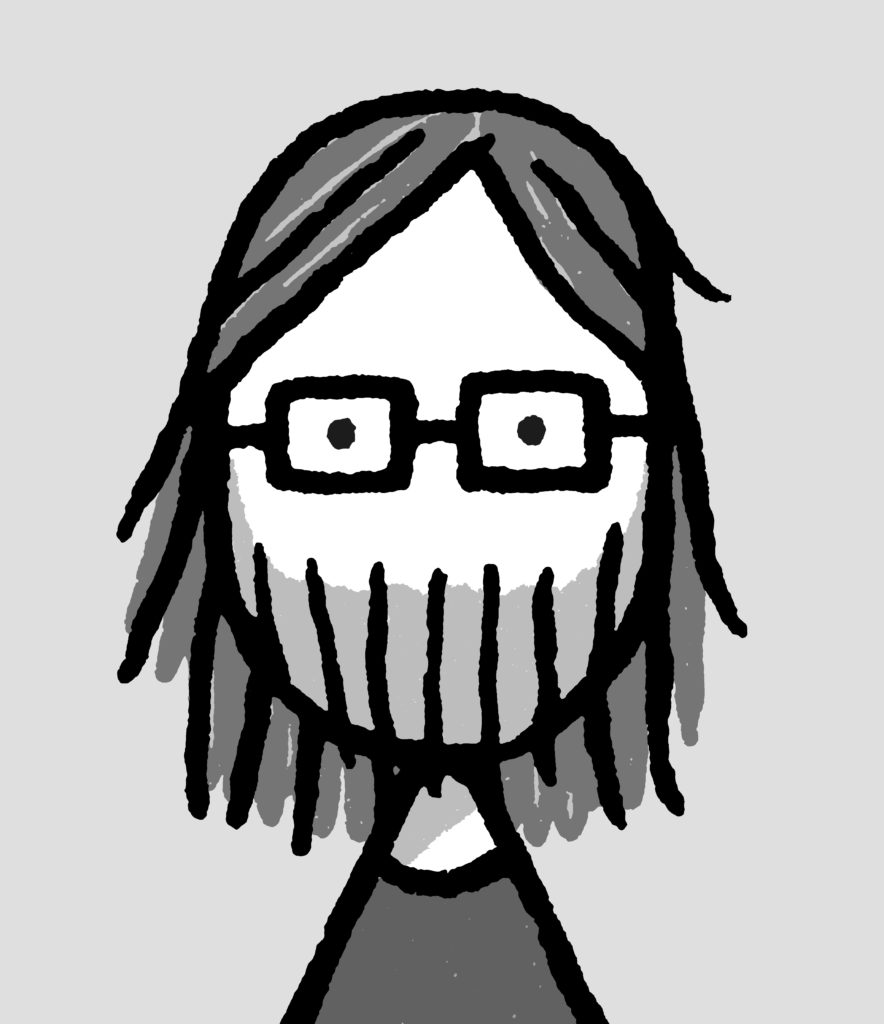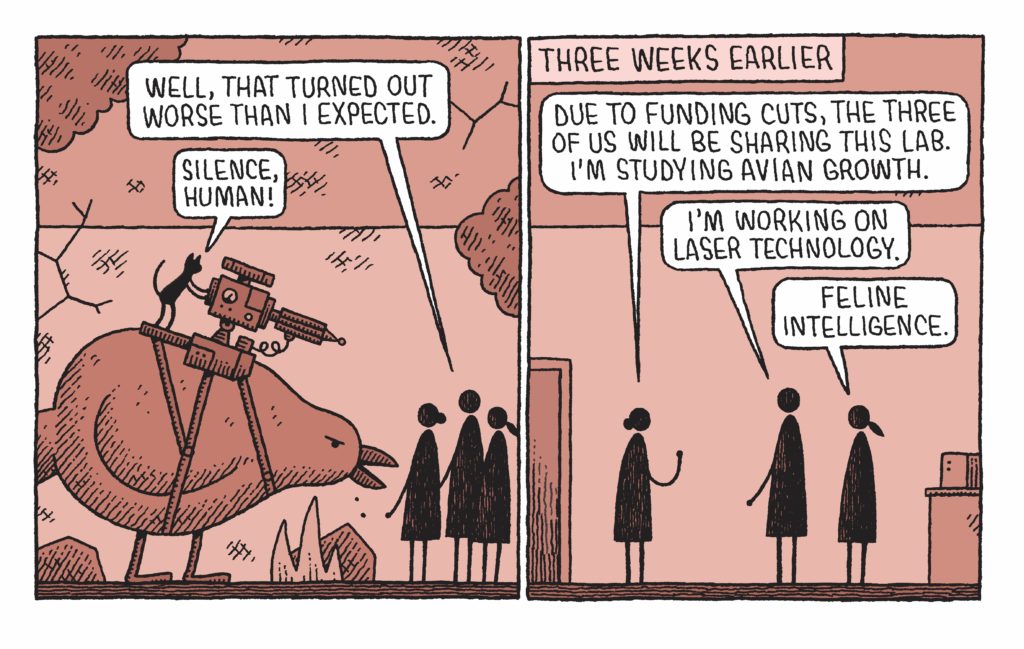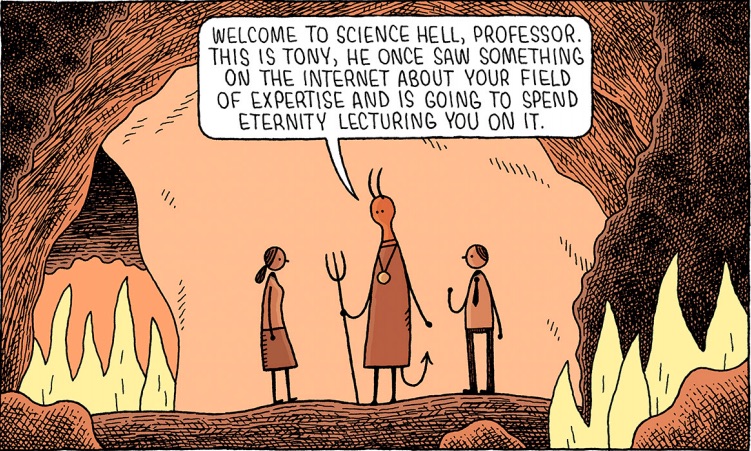
If you’ve spent any time in comics or literary circles, you’re probably familiar with the work of Tom Gauld. Gauld’s comics frequently riff on literary history, to hilarious effect. With his latest book, Department of Mind-Blowing Theories, Gauld has applied that same ethos to the world of science. It’s one that frequently leads to surreal juxtapositions, ironic reversals, and characters dealing with bizarre dilemmas. It’s also very, very funny. I talked with Gauld about the making of the new book and how he arrived at some its most sublime moments.
Some of these comics do an incredible amount of storytelling in a handful of panels — I’m thinking in particular of the one with the laser-wielding cat riding a giant bird. How do you get to something like that, and how do you figure out the best format to use?
One of the most fun parts of making these cartoons is figuring out what I need to put on the page and what I can leave (with the appropriate prompts) to happen inside the reader’s head. The cartoon you mention takes that to an extreme, where the humour really comes from the puzzle of the big gap between the two panels that the reader hopefully can enjoy solving. It’s often a case of working backwards: coming up with a full version of the story and figuring out how much can be taken away without losing the point. I make a lot of sketches, doodles and notes in my sketchbooks, for all these cartoons trying to find the most interesting way of laying things out.

Your earlier books Baking with Kafka and You’re All Just Jealous of My Jetpack both took a lot of inspiration from the world of literature. What prompted you to do a series of comics focused on science this time out?
I’ve been doing weekly literary cartoons for the Guardian for fourteen years and still really enjoy making them, but I wanted to try something new. In the past, I’d made occasional science cartoons for New Scientist magazine, so I wrote to the art director suggesting that I could do a weekly cartoon for them. When he said yes, I realized that I had a lot of work to do to improve my basic science knowledge, so I went on a sort of self-education program of reading and listening to as much science content as I could. It’s been a lot of fun playing with a whole new set of ideas and references and I’ve been relieved that the science community seems, generally, to enjoy the cartoons.
I loved the designs of some of the science fictional technology here, especially the portal to another universe. What was your process like for creating science fictional technology?
I could draw this kind of made-up technology all day long. I sometimes have to remind myself to seek out ideas from all areas of science and not just fall back on drawing robots and tech every time, however enjoyable that is.
When I’m imagining machines, I try and find a balance between believability and silliness. I once read someone saying that in comics, you’re often not trying to capture what something looks like but suggest what it does. So, I usually start by thinking what the machine is supposed to do and try and express this in the basic shapes. Then I add lots of detail (panels, buttons, levers) which are pretty meaningless, but give the impression of something complex. I believe that model makers for films like Star Wars call these details ‘greebles’.

The clash between science and magic is a recurring theme in this collection. Do you have a particular side that you fall on as a reader?
Magic, superstition and fairy tales are all fun to use in these science cartoons because they all feel to me like opposites of the cool rationality that we associate with science. Finding unexpected things and putting them together is one of the ways I come up ideas for the cartoons.
The scientific method is almost certainly our best way of rationally investigating the world, but it would be a pretty dismal world without some magic, especially in the arts. As a reader, I’m on the fence. I like science fiction which I think is often magical stories dressed up in convincingly scientific clothing.
One of the punchlines in here involves hand sanitizer. Do you feel like you’ve anticipated the zeitgeist with that one?
That’s true! My wife pointed this one out to me just last week. I don’t try to be topical in the cartoons (the hand sanitizer one was done in 2015) but things do sometimes become unexpectedly relevant. About a year ago I drew a cartoon about autonomous bicycles roaming the streets and bothering people, and the same week that it was published, I saw a video of a bicycle that could function riderless and follow a pedestrian around.
At the moment I’m avoiding making cartoons about viruses as I think there’s more than enough of that everywhere else. I’m just trying to make things that amuse people and maybe take their minds off darker things.
Art: Tom Gauld/Drawn & Quarterly
Follow Vol. 1 Brooklyn on Twitter, Facebook, and sign up for our mailing list.
